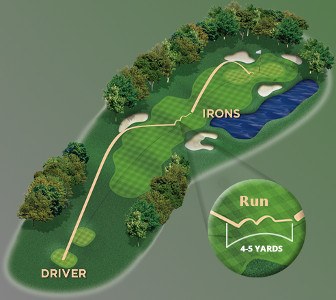
Run in Golf
Golf has its own specific terminology, and understanding these terms can greatly enhance your knowledge and enjoyment of the game. One such term commonly used in golf is “run”. In golf, the term “run” refers to the movement of a golf ball after it lands on the ground. It is the distance the ball covers on the ground after its initial impact with the turf.
Factors Affecting the Run
Several factors affect the run of a golf ball, including:
- Firmness of the Turf: The firmness of the turf plays a vital role in determining how far the golf ball will run. Softer surfaces, such as wet fairways, typically reduce the amount of run, while firmer surfaces, like dry fairways, allow the ball to run more.
- Speed and Direction of Wind: Wind can be a significant factor in determining the run of a golf ball. A headwind can reduce the amount of run, while a tailwind can increase it.
- Landing Angle: The angle at which the golf ball lands also affects its run. A steeper landing angle tends to reduce the amount of run, as the ball may dig into the turf, while a shallower landing angle promotes more roll.
- Spin: The amount of backspin or sidespin on the ball can influence its run. A ball with backspin tends to stop quickly upon landing, resulting in less roll. Conversely, a ball with less spin will have a greater tendency to run after landing.
Techniques to Influence the Run
Golfers can employ various techniques to influence the run of their shots. Two common techniques include:
- Bump-and-Run: This technique involves using a lower-lofted club, typically a wedge or a 7-iron, to keep the ball flight low and allow it to release and roll once it hits the ground. The bump-and-run is often used when there is little to no obstacles or hazards between the ball and the target.
- Greenside Flop Shot: In contrast to the bump-and-run, the flop shot is used when the golfer wants to maximize height and decrease the amount of run. This shot is executed with a high-lofted club, such as a lob wedge, to hit the ball high in the air and land it softly on the green.
Importance of Controlling the Run
Controlling the run is crucial in certain situations on the golf course. For example, when approaching a green with a pin placement close to the edge, it may require a shot with the right amount of run to get the ball close to the hole. Additionally, if the fairway is narrow or the landing area is guarded by hazards, considering the run becomes essential in choosing the appropriate club and strategy.
To conclude, understanding the golf term “run” and knowing how to control it can significantly impact your game. By considering factors such as the firmness of the turf, wind conditions, landing angle, and spin, golfers can adjust their approach shots and achieve the desired outcome. Whether executing a bump-and-run or a greenside flop shot, mastering the control of the run will undoubtedly enhance your overall golfing skills.





